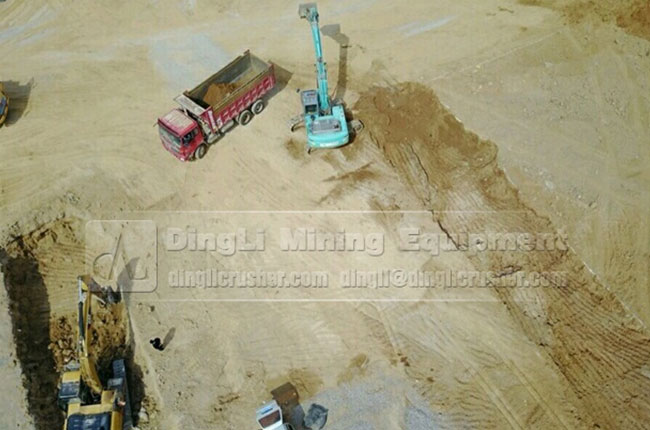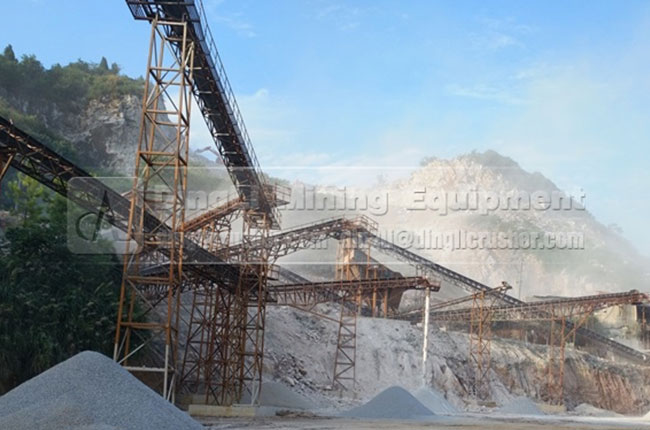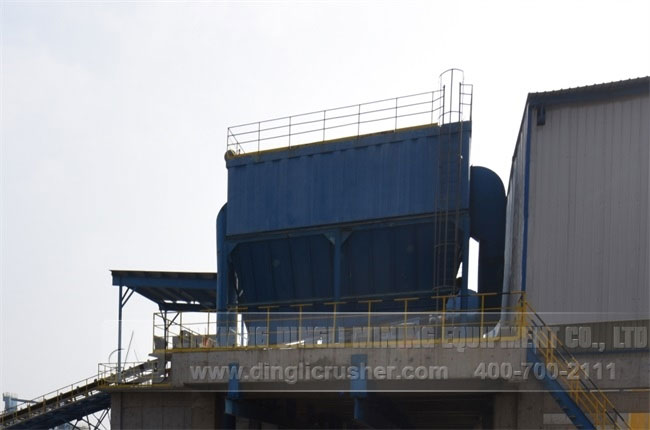 Sand Aggregate IndustryComprehensive Service Provider
Sand Aggregate IndustryComprehensive Service Provider Sand Aggregate IndustryComprehensive Service Provider
Sand Aggregate IndustryComprehensive Service Provider| Model | Cavity Type | Eccentricity | Maximum Motor Installation Power (kW) | Throughput under Closed - side Discharge Opening (CSS) (t/h) | |||||
| 25mm | 30mm | 35mm | 40mm | 45mm | 50mm | ||||
| GPY300S | Medium | 32 | 250 | 350 - 390 | 370 - 410 | 390 - 430 | |||
| 40 | 440 - 490 | 470 - 520 | |||||||
*Note: The processing capacity of the GPY300S cone crusher may vary with different materials and feeding sizes.

In Hongyuan Group construction site, there are builders welding steel for gravel production line construction.

Only configured with a heavy hammer crusher and four vibrating screens, this production line can produce six types of finished materials. Moreover the final products have sound grain shape

This production line is especially constructed for the building stone with wide application of finished material and optimized operation efficiency.
The crushing wall is installed on the moving cone of the cone crusher, and the mantle is located on the fixed cone. They are the direct force-bearing parts for crushing materials. When processing high-hardness ores such as granite, they are frequently subject to the impact and friction of materials and wear out quickly. Their wear will change the shape of the crushing chamber, affecting the product particle size and the equipment production capacity.
Including the moving cone liner and the fixed cone liner, which are designed to protect the cone. After wear, it not only changes the shape of the crushing chamber resulting in uneven product particle size but also may cause looseness and disrupt the normal operation of the equipment.
Located at the main shaft, it reduces the wear of the main shaft during rotation. Due to bearing large axial and radial forces, it is prone to wear under long-term high load, which in turn reduces the rotation accuracy of the main shaft and impairs the stability of the equipment.
Located below the feed inlet, it is responsible for evenly distributing materials to all parts of the crushing chamber. Under the impact of materials, it is prone to wear and deformation. Once damaged, the material distribution is unbalanced, and both the crushing and production efficiency are affected.
Regularly shut down the machine and check the wear marks on the surface and measure the thickness. When the wear reaches about 1/3 - 1/2 of the original thickness, consider replacement.
After cutting off the power and releasing the pressure, disassemble the old parts in order, noting the position and sequence of the parts. When installing new ones, accurately position and properly tighten them, and adjust until the crushing effect meets the standard.
Strictly control the feed amount and particle size to prevent excessive impact of materials. Regularly clean the chamber to avoid corrosion by residual materials.
Observe the surface wear, cracks and the fit with the cone. When there is looseness, severe local wear or a gap, it needs to be dealt with in a timely manner.
After shutting down the machine and cleaning the chamber, remove the old liner, protecting the cone well. When installing a new one, use special bolts and tighten them according to the specified torque to ensure a tight fit.
Regularly inspect and select a suitable material according to the characteristics of the materials and the working environment to extend the service life.
Monitor the wear by the vibration of the equipment, the temperature change of the main shaft and the metal content in the lubricating oil. Abnormal vibration, high temperature or a large number of metal particles in the oil may indicate a problem with the bushing.
Disassemble the related parts such as the pulley and the bearing, protecting the main shaft and other parts well. When installing a new bushing, accurately control the fit accuracy and apply an appropriate amount of oil, and adjust the rotation of the main shaft.
Keep the lubricating oil clean and sufficient, and avoid overloading the equipment to reduce the load on the main shaft.
Observe the surface wear, deformation and rupture. When the material distribution is uneven or the structure is damaged, it needs to be replaced.
After shutting down the machine and disassembling the feed parts, remove the old plate. When installing a new one, accurately position and firmly fix it, and adjust the angle to optimize the material distribution.
Regularly clean the surface residues to prevent accumulation. Avoid large materials directly hitting during feeding.
Familiarity with the wear parts of medium crushing cone crushers and their replacement and maintenance methods can greatly reduce the probability of equipment failure, improve production continuity and stability, lay a solid foundation for enterprises to reduce costs and increase efficiency, and help promote the efficient and orderly progress of production operations in related industries.
We are present worldwide and always here to help.
Get in touch today!